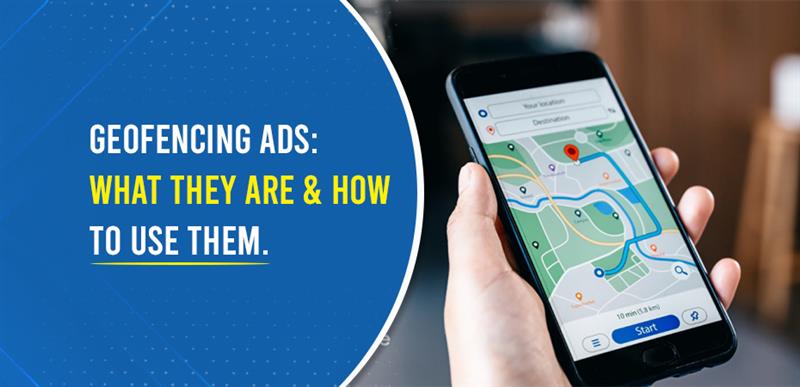Geofencing Ads: What They Are & How to Use Them



Introduction
In today’s fast-paced digital world, businesses need smart strategies to connect with their target audience at the right time and place. Enter geofencing advertising—a game-changing, location-based marketing tool that helps you engage potential customers the moment they step near a specific area.
Imagine being able to send targeted offers, promotions, or reminders to people as they pass by your store, restaurant, or office. Sounds powerful, right? Whether you want to boost foot traffic, increase conversions, or outshine competitors, geofencing ads can give you the edge you need.
But how exactly do they work, and more importantly, how can you use them to grow your business? Let’s break it down!
What Are Geofencing Ads
Geofencing ads are digital ads that appear on a person’s phone when they enter a specific area. Businesses create a virtual boundary around a location using GPS, Wi-Fi, Bluetooth, or RFID. When someone steps into this area, they receive targeted ads on their mobile device through apps, social media, or search engines.
This smart marketing method helps businesses reach the right people at the right time, increasing store visits and sales.
Examples of Geofencing Ads in Action
- A coffee shop near an office sends a 10% discount offer to employees as they pass by in the morning, encouraging them to stop for coffee.
- A clothing store in a mall sends a push notification about a special sale when shoppers enter the area, attracting more customers.
- A real estate agency shows ads for available homes to people in a specific neighborhood, helping them find properties nearby.
With geo-targeting ads, businesses can send personalized messages at the perfect moment, making it easier to connect with potential customers and boost sales.
How Geofencing Advertising Works
Geofencing ads use location data and real-time tracking to reach potential customers. Here’s how the process works:
- A geofence is created – Businesses set up a virtual boundary around a specific geographical area, such as a shopping mall, event venue, or competitor’s store.
- User enters the geofence – When someone with a smartphone or a relevant mobile app steps into this zone, the system detects their presence.
- Ads are triggered – A pre-set ad, push notification, or SMS is sent to the user’s device, delivering a personalized message at just the right moment.
- Customer engagement increases – The targeted message encourages users to visit the store, check out a deal, or take action, leading to higher foot traffic and conversions.
By using geofencing ads, businesses can attract more customers in real time and increase their chances of making a sale.
Benefits of Geofencing Ads
Geofencing marketing isn’t just a trendy tactic—it provides real, measurable advantages that help businesses grow. Here’s how:
1. Hyper-Local Targeting for Higher Conversions
Unlike traditional ads that target broad audiences, geofencing focuses on specific geographical locations, ensuring that only people in a defined area see your ads. This precision location targeting increases customer engagement and conversion rates, leading to better results.
2. Personalized Customer Experience
Geo-targeting ads allow businesses to customize promotions based on location, time, and user behavior. For example, a restaurant can send a lunch discount to nearby office workers, making offers more relevant and appealing.
3. Competitive Advantage
With geofencing, businesses can attract customers away from competitors by offering special deals when they are near rival stores. This tactic helps drive foot traffic to your business instead of your competitors’.
4. Better Data and Insights
Geofencing provides valuable customer data, such as peak visit times, how long users stay in a location, and conversion rates. These insights help businesses refine their marketing strategies for better targeting and higher ROI.
By leveraging geofencing ads, businesses can create more effective, location-based marketing campaigns that drive real results.
Industries That Benefit from Geofencing Marketing
Many industries use geofencing marketing to attract customers, boost sales, and improve engagement. Here’s how different businesses benefit:
Retail & E-commerce
Brick-and-mortar stores can use geofencing to increase foot traffic by sending special offers to shoppers nearby. E-commerce brands can retarget users who visit competitor locations, encouraging them to shop online instead.
Restaurants & Fast Food Chains
Restaurants can send exclusive meal deals to people nearby, attracting customers during lunch or dinner hours. Fast food chains can target commuters with time-sensitive promotions, increasing impulse purchases.
Healthcare & Medical Services
Hospitals, clinics, and pharmacies can use geofencing to remind patients about checkups, vaccinations, or health screenings when they are near a facility. This helps improve patient engagement and health outcomes.
Events & Entertainment
Concerts, trade shows, and sports events can use geofencing to boost ticket sales and engage attendees with special promotions, exclusive content, or real-time updates.
Real Estate
Real estate agents can target potential homebuyers searching in specific neighborhoods by showing ads for available properties nearby, increasing the chances of closing deals.
By using geo-fencing, businesses across various industries can create highly targeted, location-based advertising campaigns that drive real results.
How to Get Started With Geofencing Marketing Tools
Implementing location-based marketing is easier than you think! Follow these steps to launch an effective campaign:
Step 1: Define Your Target Location and Audience
Start by identifying high-traffic areas or locations where your ideal customers are likely to be. This could be competitor stores, event venues, shopping malls, or business districts. Choosing the right location ensures your ads reach the most relevant audience.
Step 2: Choose the Right Geofencing Platform
Pick a geofencing tool that suits your business needs. Some popular platforms include:
- Google Ads Geofencing – Geofencing on Google Ads is ideal for search and display ads.
- Facebook Location-Based Ads – Great for social media marketing.
- Simpli.fi – A powerful tool for hyper-local targeting.
- Reveal Mobile – Provides detailed location analytics.
- GroundTruth – Helps drive real-world store visits.
Step 3: Set Up Geofences and Campaign Parameters
Define your geofence size strategically—a large boundary may reach too many people with lower relevance, while a small one could limit your audience. Finding the right balance ensures effective targeting.
Next, set up triggers to engage users at the right moment. You can use app notifications, SMS, or display ads to deliver personalized messages. These timely alerts encourage customers to visit your store, explore offers, or take action, increasing conversions and boosting engagement.
Step 4: Create Engaging and Relevant Ads
Use clear, action-driven CTAs like “Limited-time offer: 20% off today!” to grab attention and encourage immediate action. A strong call to action boosts engagement and increases conversions.
Next, optimize your ads with eye-catching visuals and mobile-friendly designs to ensure they stand out and are easy to interact with. High-quality images, bold text, and responsive layouts enhance the user experience, making your ads more effective in driving clicks and conversions.
Step 5: Monitor and Optimize Your Campaigns
- Track key metrics like impressions, click-through rates, and conversions.
- Continuously refine your targeting, messaging, and timing to improve campaign performance.
By following these steps, you can maximize the potential of geofencing marketing and drive better results for your business!
Challenges and Best Practices in Geofencing Advertising
While geofencing is a powerful marketing tool, businesses must navigate certain challenges to ensure success.
Privacy Concerns
With growing concerns about data security, it’s crucial to comply with privacy laws like GDPR and CCPA. Always ensure user consent and maintain transparent data practices to build trust.
Avoiding Ad Fatigue
Too many notifications can annoy users and lead to ad fatigue. Instead of overwhelming customers, limit ad frequency and ensure messages are timely, relevant, and valuable. A well-balanced approach keeps engagement high without being intrusive.
Optimizing for Different Businesses
Every industry has unique needs, so customize geofencing strategies accordingly. A retail store may focus on in-store discounts, while a real estate agency targets buyers in specific neighborhoods. Understanding your audience ensures higher engagement and better ROI.
By addressing these challenges and following best practices, businesses can maximize the impact of their geofencing campaigns.
Future Trends in Geofencing Marketing
Geofencing marketing is evolving rapidly with advancements in technology, making it more precise and interactive. AI-driven geofencing is enhancing targeting by analyzing customer behavior, preferences, and movement patterns, allowing businesses to deliver smarter, more relevant ads.
Another exciting development is the integration of augmented reality (AR) and virtual reality (VR) in geofencing campaigns. This will create immersive advertising experiences, such as virtual store tours or interactive promotions, making ads more engaging.
Additionally, the rise of 5G technology is set to revolutionize geofencing by providing faster, more accurate location tracking, ensuring real-time ad delivery with minimal delays.
Conclusion
Geofencing ads are transforming how businesses connect with customers by providing real-time, location-based targeting. Whether you run a local business or a national brand, leveraging geofencing advertising can drive more foot traffic and conversions.
Geofencing means setting up a virtual boundary around a specific location using GPS, Wi-Fi, Bluetooth, or RFID technology to trigger targeted actions, such as sending ads, notifications, or alerts, when a user enters or exits the defined area. Using geofencing ads is beneficial as it allows businesses to deliver highly relevant, location-based promotions, increase customer engagement, drive foot traffic, and improve conversion rates by reaching the right audience at the right time.
For businesses looking to optimize their digital marketing strategies, integrating geofencing with SEO can significantly boost results. If you’re seeking expert guidance, consider working with SEO Expert services in New York to refine your marketing approach.
Frequently Asked Questions (FAQs)
Almost any business with a physical location or service area can benefit, including retail stores, restaurants, real estate agencies, and healthcare providers.
Costs vary based on ad platform, geofence size, and audience reach. A campaign may cost anywhere from $5 to $15 per CPM (cost per 1,000 impressions).
Yes, as long as it complies with privacy regulations and users provide location-tracking consent.
Accuracy depends on the technology used (GPS, Wi-Fi, Bluetooth), with some methods reaching precisions within a few meters.
Absolutely! Small businesses can target hyper-local audiences, making geofencing a cost-effective marketing strategy.